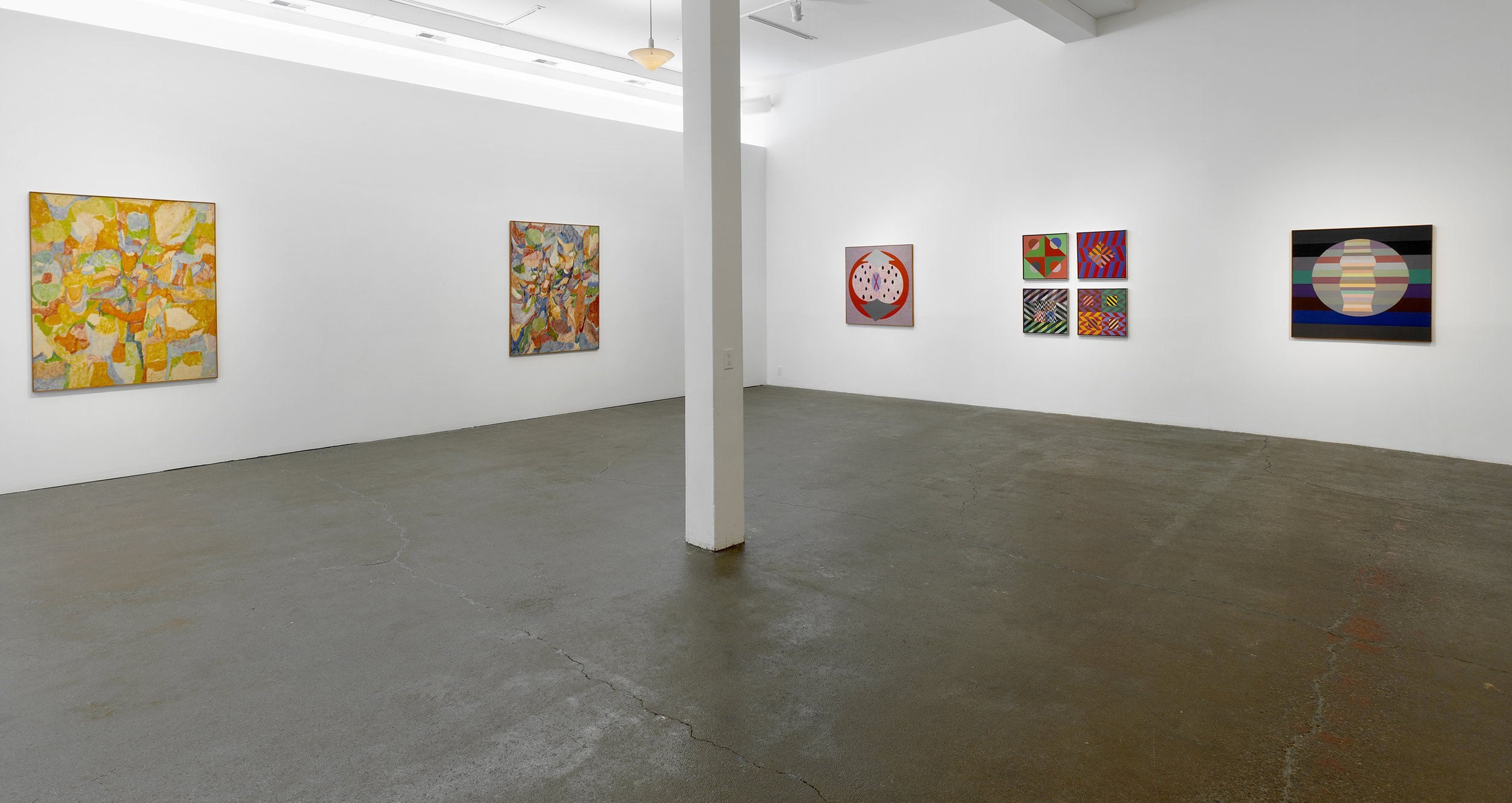Sally Cook, City of Dreams
by :
Alan Oberst
An earlier version of this article appears in the first issue of Cornelia.
In the back room of Eleven Twenty Projects, where once REO Speed Wagons were repaired, a woman appears to float – levitate almost – in an idyllic country setting surrounded by plants and trees and animals domestic and wild. The scene is as far removed as could be from the traffic and skyline of Buffalo’s Main Street out front. If it strikes the viewer as Edenic, well, the artist in this self-portrait grew up in rural Angola, New York – a place literally just down the road from Eden.
And indeed this work, I Go to Africa (1973), evokes nothing more than one of America’s most recognizable series of folk paintings, The Peaceable Kingdom by Edward Hicks, which depicts an American Eden where people and animals and nature (and settlers and natives) co-exist in harmony. It’s hard to imagine that resemblance being a coincidence given that the last major show of work by the artist, Sally Cook, at the Dana Tillou Gallery a decade ago, was named A Peaceable World.
Despite its folk characteristics and inspiration, this work is best categorized as Magic Realism, one of several genres represented in an extraordinary career that has made Cook one of our most important regional artists. Bringing more recognition to the artist and her work – the entire breadth of it – was a prime motivation behind not only this exhibit, but also the creation of the gallery itself, Eleven Twenty Projects’ founder John Fatta recently told a group of visiting arts writers.
Seeing the full arc of Cook’s career and hearing Fatta’s accompanying narrative invite comparisons to western New York’s most celebrated artist, Charles Burchfield, who also grew up in a small, rural town outside a mid-west city. Like Burchfield, Cook had talent recognized early by teachers, and also had a not entirely happy sojourn in New York City (although longer than that of Burchfield, who famously dropped out of art school there after a single class and returned home six weeks later).
Cook was encouraged to take her talent to New York City by Peter Busa, who for a short time taught at the Albright Art School where she was a scholarship student and whose own work had been shown several times at the Whitney. At the time Abstract Expressionism, promoted by influential critics like Clement Greenberg, was so dominant and synonymous with the city that it was also called the New York style. So, while in Rome Cook did as the Romans and worked in that style. Her work from that period, well-represented in this show, holds up with that of her better-known contemporaries, and would not seem out of place on the walls of the Albright-Knox. Indeed, her work merited solo shows at the storied Tenth Street Collective galleries. According to Fatta, she worked alongside artists like Helen Frankenthaler and moved in the circles of some of the biggest names in post-war art – and even writer Jack Kerouac. She lived in the scene that art critic Irving Sandler knew and chronicled so well.
Stylistically, Cook’s Abstract Expressionist canvasses have a resemblance to a Busa work of 1957 (untitled), almost a foliage comprising small patches of varying hues. Fatta characterizes them as “light and ethereal,” but that doesn’t seem to fit even the work with the light and ethereal title of White Painting (1960). That almost floral composition of muted tones harbors the suggestion of a malevolent presence in a dark patch at the center. Such hints of menace and fear can be found in all of these works, including pointed, jagged shapes not unlike those that convey such emotions in Burchfield’s early paintings such as Church Bells Ringing, Rainy Winter Night (1917). And in Convergence (1960), the center of the painting is dominated by what could be seen as the face of a fierce predator emerging from variegated foliage in which it was well camouflaged. As for “light,” two works in particular could hardly be described that way: In the Forest of the Night and Only the Lone (both 1960) are full of foreboding with their deep, dark blues and violets, suggesting a fragmented world harboring hidden dangers.
Could that have been the impression the New York art scene made on a young artist from a small town outside a medium-sized city, with its strangeness and enormity – and pressure to conform? According to Fatta, Cook resisted conformity in lifestyle and artistic style, but her contemporaries didn’t make it easy. They were not supportive when she shifted away from Abstract Expressionism, seeing before many of them that the style was played out.
As Cook told Buffalo Spree’s Bruce Adams,
“The day came when the scales fell from my eyes,” says Cook, “and I had to ask myself what possible benefit there could ever be for me to continue sitting night after night in a beer-soaked bar, waiting for some powerful person to notice me.” It was time to go, and Buffalo seemed “a good answer.”
Accompanying her back to Buffalo was a new style: Hard Edge, also well represented in this exhibit. It makes a silent yet irrefutable case for Cook’s artistic greatness that despite the drastic shift away from Ab-Ex, her work still holds up with her better-known contemporaries. The quality of the deceptively simple Starflower (1966) will be evident to anyone who saw last year’s Robert Indiana show at the Albright-Knox, which included many of his Hard Edge works.
For anyone who simplistically thinks that Hard Edge is less, well, expressive than Abstract Expressionism, this show will disabuse them of that notion. Despite their geometric abstraction, there is a sense of visual tension and even being adrift present in many of these works that perhaps reflects Cook’s stylistic and geographic break from the New York art scene. Works in her Jewels of the Middle Ground series (1969) feature bars of contrasting colors in jagged-edged collisions. Those works and the suggestively titled Sailing on a Sea of Psyche (1967) feature bars of color grouped in squares or parallelograms floating above landscapes of angular sets of colliding color bars. The foreground sets and landscape sets appear utterly unrelated or even hostile to each other, conveying a sense of alienation, or perhaps of looking for a place to land.
Of course it’s possible to read too much into Cook’s Ab-Ex and Hard Edge work, but a career retrospective, with the entire arc of an artist’s career laid out, invites interpretation. Knowing of the artist’s struggles in the alien, Darwinian world of the New York art scene also invites the viewer to seek signs of those struggles in the artist’s work. And because the artist’s various stylistic periods are mixed together in this exhibit, the viewer is never out of sight of examples of her ultimate, signature style, with its unconcealed expressionism and deeply personal subject matter. Seeing that, one could hardly believe that similar emotional and psychological content would not be present in Cook’s earlier work, and despite its abstract styles it seems to be there.
If Cook’s Hard Edge work did indeed show an artist looking for a place to land, her signature style, in which she has worked ever since, was that landing place. Clearly in the realm of Magical Realism but also clearly her own, her style is a kind of neo-folk art. Although, like folk art, her work in this style seems to reflect a sense of place, drawing elements from her own life, the land, simple farmhouse-style rooms, and views out windows to rural landscapes, it has none of the self-taught, naive ingenuousness of folk art.
Within this style her subject matter is recognizably autobiographical, often including herself at apparently different stages of her life – in one case, Self Portrait, Five Images (1975), several Sallys appear in the same work, in what is perhaps her childhood home. The viewer can only wonder what they may be telling each other. She even incorporates her earlier work into later paintings as art on the wall (in one, we see one of her Hard Edge works hanging on the wall next to a painting of a cat).
It is not all idyllic, though, as shown in Look Out (1976) where a lone woman – Cook’s friend, Bonnie (who has appeared in other work by the artist not in this exhibit) – stands alone, in an all-red room, the walls covered in stencils of a skull-and-crossbones motif. Although dressed to the nines as if heading for a night on the town (or given the year, perhaps a night at the disco), she does not seem at all happy. It resembles nothing so much as an unsettling image from a David Lynch film.
One of the exhibit’s most important works seems to embody all the other work in this style, as if a kind of culmination and artist statement. In Clothed by Art in the Garden of Creativity (1983), two Sally Cooks, one standing and one floating, appear in an idealized landscape with birds and butterflies, wearing only vines and flowers. Arms outstretched, the standing Sally holds a small bouquet of flowers in one hand and a set of paint brushes in the other. She seems to be telling us, “I’m here. This is where I am. I’m at peace. This is who I am. What you see is what you get.” It seems nothing short of a masterpiece of self-expression.
Having demonstrated this talent and mastery of styles, and having achieved this clarity, confidence, and unique voice, and having developed this signature style based on a sense of place, it seems almost inevitable that Sally Cook became one of western New York’s most important regional artists. According to Eleven Twenty Projects, in 2015 Cook was designated a “Living Legacy” artist by the Burchfield-Penney Art Center, where her work will be featured in the upcoming “History of Painting in WNY” exhibit this fall. Next February, University at Buffalo’s Anderson Gallery will exhibit a major retrospective of her work, presumably including works from “City of Dreams.”
In finding her ultimate artistic and geographic landing places, Cook’s arc continues to have interesting parallels to that of Charles Burchfield. After sojourns in New York City, both found themselves in Buffalo (both in the Allentown neighborhood, although generations apart), and both eventually returned to rural, small-town settings (Burchfield to Gardenville and Cook to Silver Creek). And after detours through other styles (Burchfield spent two decades painting in the American Scene), both created unique, highly expressionistic ways of conveying a deeply personal, mystical sense of nature and place.
Thankfully, both Cook and Burchfield reached a place where each could say, through their art, “I’m here. This is where I am. I’m at peace. This is who I am. What you see is what you get.” Western New York as a region is so much richer for having them.
Alan Oberst's writing has appeared in Buffalo Rising, Buffalo Spree, Artvoice, and City and State NY. He has written about architecture, development, planning, public policy, and –yes–art.
Sally Cook, City of Dreams
May 31 – August 2, 2019
Eleven Twenty Projects
1120 Main Street, Buffalo NY 14209
eleventwentyprojects.com

